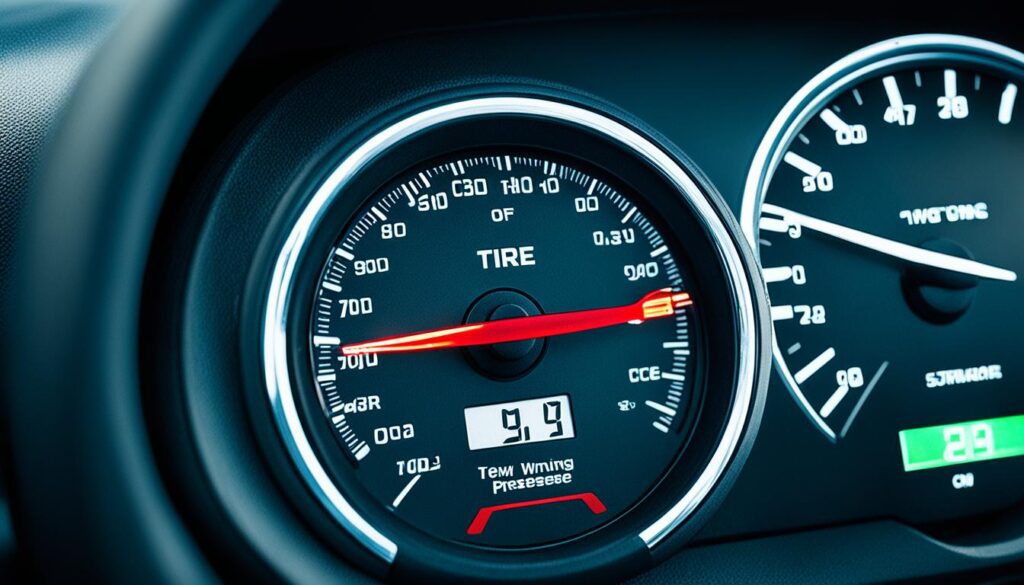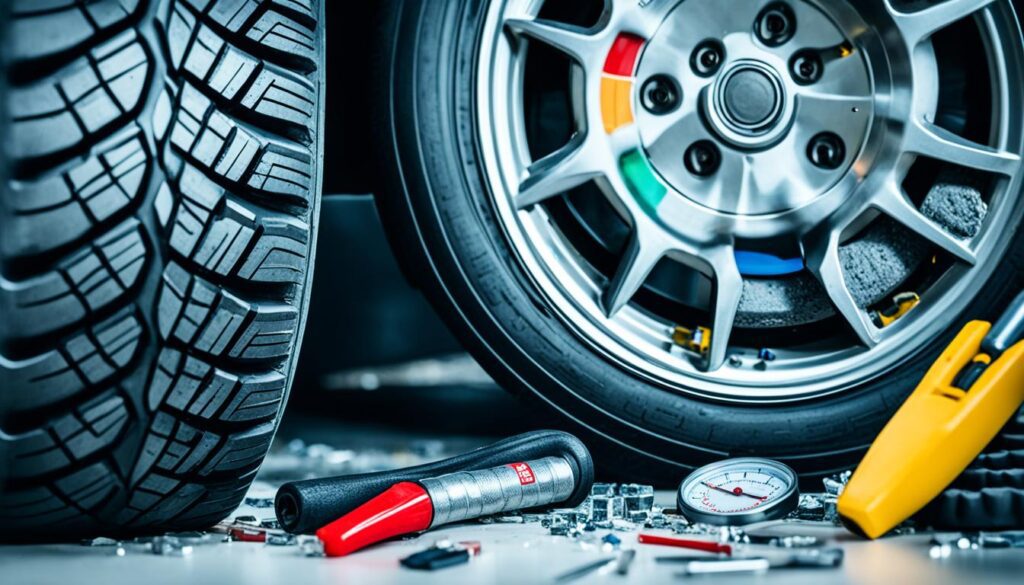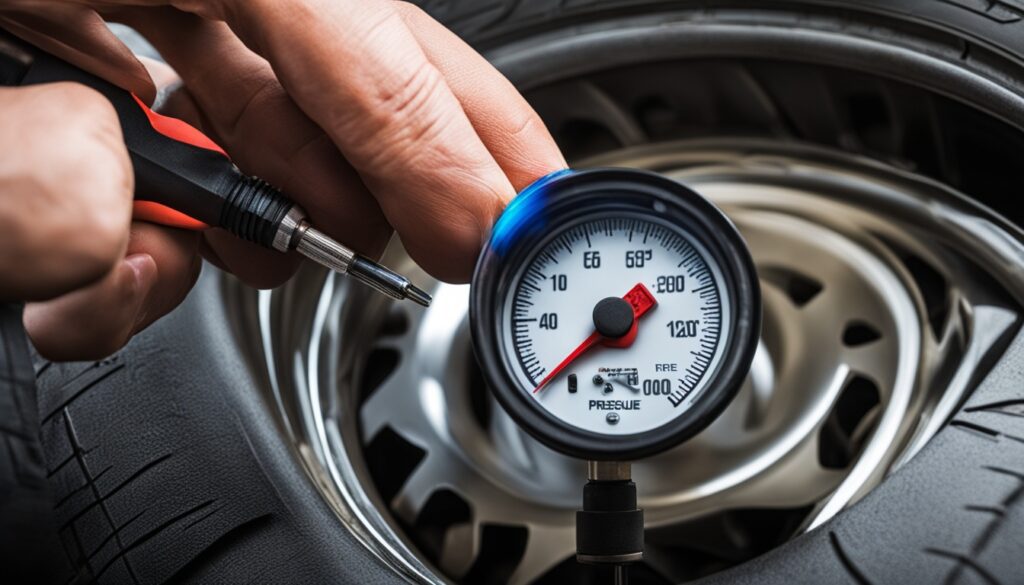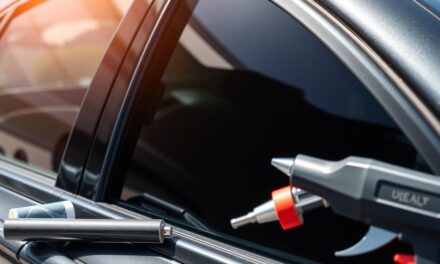Did you know that every year, tire problems cause about 11,000 road accidents? Many of these are because of low tire pressure. When you see the low tire pressure light on your dashboard, it’s very important. It means your safety and how well your car drives could be at risk. Driving on tires that don’t have enough air can make it harder to control your car. It can also make you use more gas and wear out your tires faster. This can end up costing you a lot.
But don’t worry, fixing low tire pressure can be easy. Usually, you just need to use a good tire pressure gauge to check the pressure. Sometimes, your tire might need a quick patch from a tire expert. Understanding why your tires are losing air is important. It can help you prevent the same problem in the future. Make sure to take care of low tire pressure problems quickly. This keeps your drive smooth and safe.
Understanding Low Tire Pressure Warning Signs
Your car talks to you in its own way, warning you of dangers ahead. Knowing when it warns about tire pressure can prevent trouble. It’s key to watch for signs and keep the right tire pressure.
Recognizing the TPMS Alert
New cars have a tire pressure sensor in the TPMS. It tells you when tire pressure is too low. A symbol lights up on your dash for this. It looks like a flat tire with an exclamation mark. Seeing it means you should check your tires soon.

Assessing Tire Pressure Visually
It’s good to check your tires by looking at them. If they look different suddenly, it could mean there’s a problem. But not all tire issues are easy to see. That’s why using a gauge to check pressure often is a good idea.
Importance of Optimal Tire Pressure
Right tire pressure keeps you safe and saves gas. It also makes your tires last longer. Tires that are not full enough can make driving unsafe. Low tire pressure is risky. Checking your tire pressure often keeps you safe on the road.
Common Causes of Low Tire Pressure
Keeping an eye on your tire pressure is key. You need to know what should my tire pressure be. Also, recognize when what tire pressure is too low. Many hidden reasons can make tire pressure drop. It’s important to know them to keep your rides safe and smooth.
- Road Debris and Punctures: Sharp things like nails can puncture tires. This causes air to leak slowly.
- Wheel Condition: The shape of your wheels is very important. If they’re bent, air can escape from the tires.
- Temperature Fluctuations: Tires don’t like when the weather changes a lot. Cold weather makes them lose air. Check and adjust the pressure often.
- Ageing Tires: Old tires can’t hold air well. They become less flexible over time. This may mean you need new tires.
It’s vital to know what tire pressure is too low. Low tire pressure is not just a small problem. It’s a big safety issue. Driving with low tires can lead to accidents because it’s harder to control the car.
So, keep track of what should my tire pressure be. Spot the signs when what tire pressure is too low. This way, you can fix problems early. And your travels will be both safe and efficient.
How to Diagnose and Address Tire Leaks
When the low tire pressure warning light turns on, your tires might be leaking. It’s important to fix tire leaks fast for safety and maintenance. Here’s a simple guide to find and fix tire leaks and keep your tires at the right pressure.
Identifying Punctures and Damages
Start by checking your tires for punctures or damage. Look for nails, glass, or sharp objects in the tire. If you find something, fix it quickly to avoid more air loss and damage when driving.

Checking and Repairing Valve Stems
Valve stem issues can also cause leaks. They may get damaged by age, corrosion, or being too tight. Look for wear or damage on the valve stems. A hissing sound means air is escaping and it’s time to replace the valve. This easy fix stops more air from leaking and keeps your tires right for travel.
Dealing with Temperature Fluctuations
Temperature changes affect tire pressure. A 10°F change can alter pressure by 2%. When seasons change or temperatures swing, check and adjust tire pressure. This keeps it ideal for your vehicle and tire type.
By keeping an eye on these issues, you can keep your tires in great shape. This way, the low tire pressure light won’t bother you often.
Low Tire Pressure Quick Fixes
Low tire pressure is annoying but easy to fix. You can patch it up yourself or check sensors quickly. These easy fixes will help your tires last longer and keep you safe on the road.

Simple Patching Techniques for Tires
Got a tire puncture? Don’t worry, easy patching can help. Use sealants or tire plugs for small holes. But remember, these fixes are temporary. If the damage is on the tire’s side, get professional help.
Fixing Faulty Tire Pressure Sensors
Sometimes, tire pressure sensors might not work right. They might need recalibration or replacement. These sensors are key for safety, giving real-time alerts. Fixing them keeps your alerts accurate and dependable.
Preventative Measures for Maintaining Tire Pressure
Keeping your tires at the right pressure is important. Check your tire pressure often with a good gauge. This simple step helps avoid problems and keeps your car in top shape. It also makes your car safer and more fuel-efficient.
- Use a calibrated tire pressure gauge for accurate readings.
- Inspect your tires and sensors regularly, making corrections as necessary.
- Keep a tire repair kit in your vehicle for emergencies.
Conclusion
Keeping your tires at the right pressure is very important. It keeps you safe and improves your car’s work. With a good tire pressure gauge, you can spot changes early. This helps you fix issues quickly to avoid problems from low tire pressure. Good tire pressure also makes your car use less gas and tires last longer. So, checking your tires often helps stop unexpected problems on the road.
A warning light for low tire pressure tells you to check your tires. Sometimes, a nail puncture or old wheel parts are the cause. You can sometimes fix these problems quickly. But, it’s important to also get your car checked by a pro. This is because even a small mistake in reading tire pressure can cause big problems later.
By making sure your tires always have the right pressure, you’re helping your car work better and keeping yourself safe. If your car tells you to check the tires, or if it’s time for a check-up, ask a car professional to take a look. They can make sure everything is working right. Paying attention to your tire pressure is worth it. It makes your trips smoother and saves money on gas.
Last Updated: April 29, 2024





Recent Comments